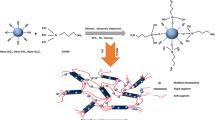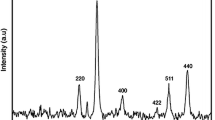Abstract
In the last few years, Poly (glycerol sebacate urethane) (PGSU), a novel elastomeric polyester, has been noticeably investigated in tissue engineering as it is known as a modified version of Poly (glycerol sebacate) (PGS) wherein hexamethylene diisocyanate (HDI) act as a crosslinker. In the present study, a series of PGSU-based nanocomposites were synthesized and characterized to achieve desirable elastomeric materials as a promising candidate for soft tissue engineering as well as controllable delivery of drugs. For this purpose, two kinds of nanoclay in the commercial name of Cloisite Na+ and Cloisite 10 A were selected to prepare PGSU nanocomposites. XRD and FTIR analysis proved the successful preparation of nanocomposites with intercalated structures. DMTA results indicated that both nanoclays enhanced storage modulus. It was also found that while Cloisite Na+ increased the glass transition temperature of PGSU, Cloisite 10 A reduced it. According to the TGA data, the thermal stability of PGSU was increased by adding Cloisite Na+. Finally, regarding the difference in the hydrophilic nature of Cloisite Na+ and Cloisite 10 A, the contact angle measurement and hydrolytic degradation revealed that each kind of the nanoclays had a different impression on the hydrophilicity and hydrolytic mass loss of the PGSU matrix.










Similar content being viewed by others
References
Hosseini Chenani F, Rezaei VF, Fakhri V, Wurm FR, Uzun L, Goodarzi V (2021) Green synthesis and characterization of poly (glycerol‐azelaic acid) and its nanocomposites for applications in regenerative medicine. J Appl Polym Sci 138(24):50563. https://doi.org/10.1002/app.50563
Saeedi M, Vahidi O, Goodarzi V, Saeb MR, Izadi L, Mozafari M (2017) A new prospect in magnetic nanoparticle-based cancer therapy: Taking credit from mathematical tissue-mimicking phantom brain models. Nanomed Nanotech Biol Med 13(8):2405–2414. https://doi.org/10.1016/j.nano.2017.07.013
Farah S, Anderson DG, Langer R (2016) Physical and mechanical properties of PLA, and their functions in widespread applications – A comprehensive review. Adv Drug Deliv Rev 107:367–392. https://doi.org/10.1016/j.addr.2016.06.012
Wang Y, Ameer GA, Sheppard BJ, Langer R (2002) A tough biodegradable elastomer. Nat Biotechnol 20:602–606. https://doi.org/10.1038/nbt0602-602
Pomerantseva I, Krebs N, Hart A, Neville CM, Huang AY, Sundback CA (2009) Degradation behavior of poly(glycerol sebacate). J Biomed Mater Res Part A 91A(4):1038–1047. https://doi.org/10.1002/jbm.a.32327
Sun Z-J et al (2009) The application of poly (glycerol–sebacate) as biodegradable drug carrier. Biomaterials 30(28):5209–5214. https://doi.org/10.1016/j.biomaterials.2009.06.007
Lin D et al (2020) A viscoelastic PEGylated poly(glycerol sebacate)-based bilayer scaffold for cartilage regeneration in full-thickness osteochondral defect. Biomaterials 253:120095. https://doi.org/10.1016/j.biomaterials.2020.120095
Salehi S, Bahners T, Gutmann JS, Gao S-L, Mäder E, Fuchsluger TA (2014) Characterization of structural, mechanical and nano-mechanical properties of electrospun PGS/PCL fibers. RSC Adv 4(33):16951–16957. https://doi.org/10.1039/C4RA01237B
Deniz P, Guler S, Çelik E, Hosseinian P, Aydin HM (2020) Use of cyclic strain bioreactor for the upregulation of key tenocyte gene expression on Poly(glycerol-sebacate) (PGS) sheets. Mater Sci Eng C 106:110293. https://doi.org/10.1016/j.msec.2019.110293
Frydrych M, Chen B (2017) Fabrication, structure and properties of three-dimensional biodegradable poly(glycerol sebacate urethane) scaffolds. Polymer (Guildf) 122:159–168. https://doi.org/10.1016/j.polymer.2017.06.064
Wu T, Frydrych M, O’Kelly K, Chen B (2014) Poly (glycerol sebacate urethane)–cellulose nanocomposites with water-active shape-memory effects. Biomacromolecules 15(7):2663–2671. https://doi.org/10.1021/bm500507z
Yang L-Q et al (2013) Biodegradable cross-linked poly(trimethylene carbonate) networks for implant applications: Synthesis and properties. Polymer (Guildf) 54(11):2668–2675. https://doi.org/10.1016/j.polymer.2013.03.059
Peña-Parás L, Sánchez-Fernández JA, Vidaltamayo R (2017). In: Martínez LMT, Kharissova OV, Kharisov BI (eds) “Nanoclays for Biomedical Applications BT - Handbook of Ecomaterials. Springer International Publishing, Cham, pp 1–19
Dawson JI, Oreffo ROC (2013) Clay: New Opportunities for Tissue Regeneration and Biomaterial Design. Adv Mater 25:4069–4086. https://doi.org/10.1002/adma.201301034
Goodarzi V, Monemian SA, Angaji MT, Motahari S (2008) Improvement of thermal and fire properties of polypropylene. J Appl Polym Sci 110:2971–2979. https://doi.org/10.1002/app.28892
Monemian SA, Goodarzi V, Zahedi P, Angaji MT (2007) PET/imidazolium-based OMMT nanocomposites via in situ polymerization: Morphological, thermal, and nonisothermal crystallization studies. Adv Polym Technol 26:247–257. https://doi.org/10.1002/adv.20105
Beryl. JR, Xavier JR (2021) A study on the anticorrosion performance of epoxy nanocomposite coatings containing epoxy-silane treated nanoclay on mild steel in chloride environment. J Polym Res 28:189. https://doi.org/10.1007/s10965-021-02512-2
Cervantes-Uc JM, Cauich-Rodríguez JV, Vázquez-Torres H, Garfias-Mesías LF, Paul DR (2007) Thermal degradation of commercially available organoclays studied by TGA–FTIR. Thermochim Acta 457(1):92–102. https://doi.org/10.1016/j.tca.2007.03.008
Zhang X, Jia C, Qiao X, Liu T, Sun K (2016) Porous poly(glycerol sebacate) (PGS) elastomer scaffolds for skin tissue engineering. Polym Test 54:118–125. https://doi.org/10.1016/j.polymertesting.2016.07.006
Zidan TA, Yehia AA, Abdelhamid AE (2021) Crosslinked poly(methacrylic acid)/organoclay nanocomposites: synthesis, characterization and methylene blue adsorption from aquatic environments. J Polym Res 28:306. https://doi.org/10.1007/s10965-021-02665-0
Abdollahi MF, Zandi M, Shokrollahi P, Ehsani M (2015) Synthesis and characterization of curcumin segmented polyurethane with induced antiplatelet activity. J Polym Res 22(9):179. https://doi.org/10.1007/s10965-015-0824-1
Pielichowska K, Król K, Majka TM (2016) Polyoxymethylene-copolymer based composites with PEG-grafted hydroxyapatite with improved thermal stability. Thermochim Acta 633:98–107. https://doi.org/10.1016/j.tca.2016.03.021
Saha M, Ray R, Choudhury AR et al (2021) Impact of exfoliation/intercalation of nano-clay on structure, morphology and electrical properties of poly (ethylene oxide) based solid nanocomposite electrolytes. J Polym Res 28:299. https://doi.org/10.1007/s10965-021-02657-0
Batool R, Altaf F, Hameed MU et al (2021) In situ chemical synthesis and characterization of PAN/clay nanocomposite for potential removal of Pb+2 ions from aqueous media. J Polym Res 28:312. https://doi.org/10.1007/s10965-021-02674-z
Mohamed MG, Mahdy A, Obaid RJ et al (2021) Synthesis and characterization of polybenzoxazine/clay hybrid nanocomposites for UV light shielding and anti-corrosion coatings on mild steel. J Polym Res 28:297. https://doi.org/10.1007/s10965-021-02657-0
Stanly S, John H (2021) Uncarbonized crosslinked PVA-modified MMT/reduced graphene hybrid aerogel for efficient carbon dioxide adsorption at low pressure. J Polym Res 28:280. https://doi.org/10.1007/s10965-021-02614-x
Panwar V, Pal K (2017) Chapter 12- Dynamic mechanical analysis of clay–polymer nanocomposites, K. Jlassi, M. M. Chehimi, and S. B. T.-C.-P. N. Thomas, Eds. Elsevier pp. 413–441
Chowreddy RR, Nord-Varhaug K, Rapp F (2019) Recycled Poly(Ethylene Terephthalate)/Clay Nanocomposites: Rheology, Thermal and Mechanical Properties. J Polym Environ 27(1):37–49. https://doi.org/10.1007/s10924-018-1320-6
Mohanty S, Nayak SK (2007) Effect of clay exfoliation and organic modification on morphological, dynamic mechanical, and thermal behavior of melt‐compounded polyamide‐6 nanocomposites. Polym Compos 28(2):153–162. https://doi.org/10.1002/pc.20284
Park HM, Li X, Jin CZ, Park CY, Cho WJ, Ha CS (2002) Preparation and properties of biodegradable thermoplastic starch/clay hybrids. Macromol Mater Eng 287(8):553–558. https://doi.org/10.1002/1439-2054(20020801)287:8<553::AID-MAME553>3.0.CO;2-3
Huskić M, Žigon M, Ivanković M (2013) Comparison of the properties of clay polymer nanocomposites prepared by montmorillonite modified by silane and by quaternary ammonium salts. Appl Clay Sci 85:109–115. https://doi.org/10.1016/j.clay.2013.09.004
Ionita D, Cristea M, Gaina C (2020) Prediction of polyurethane behaviour via time-temperature superposition: Meanings and limitations. Polym Test 83:106340. https://doi.org/10.1016/j.polymertesting.2020.106340
Goodarzi V, Kokabi M, Razzaghi Kashani M, Reza Bahramian A (2014) Prediction of long‐term mechanical properties of PVDF/BaTiO3 nanocomposite. J Appl Polym Sci 131(16). https://doi.org/10.1002/app.40596
Szlachta M, Ordon K, Nowicka K, Pielichowska K (2020) Thermal properties of polyurethane-based composites modified with chitosan for biomedical applications. J Therm Anal Calorim. https://doi.org/10.1007/s10973-020-09283-w
Mohomane SM, Djokovic V, Thomas S, Luyt AS (2011) Polychloroprene nanocomposites filled with different organically modified clays: Morphology, thermal degradation and stress relaxation behaviour. Polym Test 30(5):585–593. https://doi.org/10.1016/j.polymertesting.2011.03.002
Nagarajan M, Benjakul S, Prodpran T, Songtipya P (2014) Characteristics of bio-nanocomposite films from tilapia skin gelatin incorporated with hydrophilic and hydrophobic nanoclays. J Food Eng 143:195–204. https://doi.org/10.1016/j.jfoodeng.2014.06.038
Chiou B-S, Yee E, Glenn GM, Orts WJ (2005) Rheology of starch–clay nanocomposites. Carbohydr Polym 59(4):467–475. https://doi.org/10.1016/j.carbpol.2004.11.001
Woodard LN, Grunlan MA (2018) Hydrolytic degradation and erosion of polyester biomaterials. ACS Macro Lett7(8):976–982. https://doi.org/10.1021/acsmacrolett.8b00424
Gaharwar AK et al (2015) Elastomeric nanocomposite scaffolds made from poly(glycerol sebacate) chemically crosslinked with carbon nanotubes. Biomater Sci 3(1):46–58. https://doi.org/10.1039/C4BM00222A
Paul M-A, Delcourt C, Alexandre M, Degée P, Monteverde F, Dubois P (2005) Polylactide/montmorillonite nanocomposites: study of the hydrolytic degradation. Polym Degrad Stab 87(3):535–542. https://doi.org/10.1016/j.polymdegradstab.2004.10.011
Author information
Authors and Affiliations
Corresponding authors
Ethics declarations
Conflict of interest
There is no conflict and interest for this paper. All of persons had same contribution on this paper.
Additional information
Publisher’s Note
Springer Nature remains neutral with regard to jurisdictional claims in published maps and institutional affiliations.
Highlights
• PGSU/Clay nanocomposites were successfully synthesized using Cloisite Na+ and Cloisite 10 A.
• The successful formation of intercalated structures was proved by the XRD technique.
• Both nanoclays noticeably affected the viscoelastic properties and Tg value of PGSU.
• The hydrophilicity of nanocomposites showed highly dependence on the nanoclay types.
Supplementary information
Below is the link to the electronic supplementary material.
Rights and permissions
About this article
Cite this article
Monem, M., Ahmadi, Z., Fakhri, V. et al. Preparing and characterization of Poly(glycerol-sebacic acid-urethane) (PGSU) nanocomposites: clearing role of unmodified and modified clay nanoparticles. J Polym Res 29, 25 (2022). https://doi.org/10.1007/s10965-021-02866-7
Received:
Accepted:
Published:
DOI: https://doi.org/10.1007/s10965-021-02866-7




